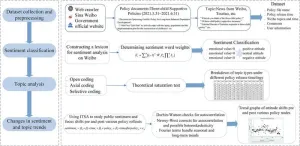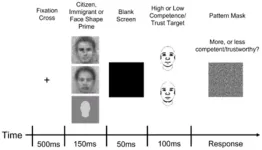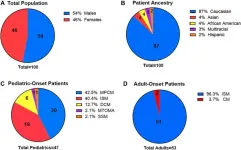(Press-News.org) From studying the human genome, to analyzing the way proteins are encoded, or monitoring RNA expression, researchers are rapidly gaining a far richer understanding of the complex genetic and cellular mechanisms that underpin dementia. But there’s a catch: While new technologies are revealing myriad avenues for Alzheimer’s research, it’s impossible to know in advance which research pathways will lead to effective treatments.
“We have countless potential targets, but we don’t know which ones to aim at,” said Greg Carter, the Bernard and Lusia Milch Endowed Chair at the Jackson Laboratory (JAX), who led the study. “Drug development is slow and costly, so to make use of these new insights, we need a way to prioritize them effectively.”
Now, Carter and his colleagues at JAX—in collaboration with partners from Stanford University School of Medicine, Emory University, and Sage Bionetworks—are doing just that, offering the first comprehensive ranking of the relative role and significance of every gene and protein in the disease’s development. The work is reported in the July issue of Alzheimer’s & Dementia in advance of the Alzheimer's Association International Conference on July 28, where the work will be presented.
“This is the most comprehensive study to date of Alzheimer’s patients’ brains,” Carter said. “We’re integrating research from multiple fields, including genetics and -omics, across the patient’s lifespan, and at a much larger scale than has previously been possible.”
The team used machine learning to draw together and overlay findings from more than two dozen large-scale genetic studies, along with multi-omic analyses of almost 2,900 brains, to identify thousands of potential targets for therapeutic interventions. The targets were then sorted into 19 separate “biodomains” reflecting biological mechanisms believed to contribute to Alzheimer’s disease.
Carter and his colleagues didn’t just want a long list of undifferentiated gene and protein targets. Instead, each target is associated with a specific therapeutic hypothesis—making it easier to understand how it works, and to identify candidates for experimental validation.
The team was also able to flag targets likely to play a role in the early stages of Alzheimer’s, supporting the development of new diagnostic and therapeutic tools for pre-symptomatic interventions. “This is incredibly important, but also very challenging: most of our data come from post-mortem brains, so our job was like trying to deduce where a forest fire began after everything has been incinerated,” said Carter. “Our computer modeling effectively rewinds the progression of the disease to identify early markers that correspond to late-stage pathology.”
That approach is already generating important insights, including new evidence that mitochondria—the powerhouse of the cell—could play a significant role in the early stages of Alzheimer’s disease. The team found a number of promising targets in this biodomain, suggesting that mitochondrial function could be a very strong early indicator of Alzheimer’s—and a key driver of the disease’s progression.
The findings and their full dataset are being made publicly available through the Emory-Sage-Structural Genomics Consortium-JAX TREAT-AD Center, part of an NIH-funded consortium dedicated to de-risking Alzheimer’s research, giving researchers and biotech innovators a foundational tool to support smarter and more targeted future research. “We’re taking an aggressively open approach,” said Carter. “If any biotech or pharmaceutical company wants to pick this up and run with it, they can—and we hope they will.”
END
New analysis offers most comprehensive roadmap to date for more targeted Alzheimer’s research and drug discovery
Researchers at The Jackson Laboratory offer the first comprehensive ranking of the relative role and significance of every known gene and protein in the development of Alzheimer’s disease
2024-07-24
ELSE PRESS RELEASES FROM THIS DATE:
Hens blush when they are scared or excited
2024-07-24
Hens fluff their head feathers and blush to express different emotions and levels of excitement, according to a study publishing July 24, 2024, in the open-access journal PLOS ONE by Cécile Arnould and colleagues from INRAE and CNRS, France.
Facial expressions are an important part of human communication that allow us to convey our emotions. Scientists have found similar signals of emotion in other mammals such as dogs, pigs and mice. Although birds can produce facial expressions by moving their head feathers and flushing their skin, it is unclear whether they express emotions in this way. To investigate, researchers filmed ...
Weibo posts illuminate public response to China’s three-child policy measures
2024-07-24
An analysis of comments on Chinese social media platform Sina Weibo reveals trends in the public response to measures implemented to support China’s three-child policy, highlighting concerns about women’s rights and employment. Lijuan Peng of Zhejiang Gongshang University in Hangzhou, China, and colleagues present these findings in the open-access journal PLOS ONE on July 24, 2024.
For decades, China’s one-child policy restricted most families to having just one child. In 2021, to combat a falling birthrate, China introduced its three-child policy, allowing couples to have up to three children. To help encourage childbirth, ...
Our ability to recognize music might not diminish with age, with older concert attendees identifying themes in music as well as younger participants
2024-07-24
Our ability to recognize music might not diminish with age, with older concert attendees identifying themes in music as well as younger participants
###
Article URL: https://journals.plos.org/plosone/article?id=10.1371/journal.pone.0305969
Article Title: Age and familiarity effects on musical memory
Author Countries: Canada, UK
Funding: The author(s) disclosed receipt of the following financial support for the research, authorship, and/or publication of this article: this work was supported by BRZ’s Natural Sciences and Engineering Research Council of Canada grant. The funders had no role ...
The COVID-19 pandemic slowed progress towards health-related Sustainable Development Goals and increased inequalities
2024-07-24
The COVID-19 pandemic significantly widened existing economic and health disparities between wealthy and low-income countries and slowed progress toward health-related Sustainable Development Goals (SDGs), according to a new study published July 24, 2024, in the open-access journal PLOS ONE by Wanessa Miranda of Federal University of Minas Gerais, Brazil, and colleagues.
The global SDGs were established in 2015 as a wide and integrated agenda with themes ranging from eradicating poverty and promoting well-being to addressing socioeconomic ...
Even people who harbor positive sentiments toward immigrants imagine immigrants' faces as less trustworthy and less competent than US citizens' faces
2024-07-24
Even people who harbor positive sentiments toward immigrants imagine immigrants' faces as less trustworthy and less competent than US citizens' faces
###
Article URL: https://journals.plos.org/plosone/article?id=10.1371/journal.pone.0306872
Article Title: Intergroup evaluative bias in facial representations of immigrants and citizens in the United States
Author Countries: USA
Funding: This work was facilitated by the National Science Foundation Division of Behavioral and Cognitive Sciences, grant #1764097 awarded to ART and grant #2215236 awarded to ...
Southern Ocean absorbing more CO2 than previously thought, study finds
2024-07-24
New research led by the University of East Anglia (UEA) and Plymouth Marine Laboratory (PML) has found that the Southern Ocean absorbs more carbon dioxide (CO2) than previously thought.
Using direct measurements of CO2 exchange, or fluxes, between the air and sea, the scientists found the ocean around Antarctica absorbs 25% more CO2 than previous indirect estimates based on shipboard data have suggested.
The Southern Ocean plays a major role in absorbing CO2 emitted by human activities, a process vital for controlling the Earth's climate. However, there are big uncertainties ...
Saharan dust regulates hurricane rainfall
2024-07-24
Giant plumes of Sahara Desert dust that gust across the Atlantic can suppress hurricane formation over the ocean and affect weather in North America.
But thick dust plumes can also lead to heavier rainfall – and potentially more destruction – from landfalling storms, according to a July 24 study in Science Advances. The research shows a previously unknown relationship between hurricane rainfall and Saharan dust plumes.
“Surprisingly, the leading factor controlling hurricane precipitation is not, as traditionally thought, sea surface temperature or humidity in the atmosphere. Instead, it’s Sahara dust,” said the corresponding ...
Fighting leukemia by targeting its stem cells
2024-07-24
Acute myeloid leukaemia is one of the deadliest cancers. Leukaemic stem cells responsible for the disease are highly resistant to treatment. A team from the University of Geneva (UNIGE), University Hospital of Geneva (HUG), and Inserm has made a breakthrough by identifying some of the genetic and energetic characteristics of these stem cells, notably a specific iron utilisation process. This process could be blocked, leading to the death or weakening of these stem cells without affecting healthy cells. These results, published in Science Translational Medicine, pave the way for new therapeutic strategies.
Acute ...
NASA’s Webb images cold exoplanet 12 light-years away
2024-07-24
An international team of astronomers using NASA’s James Webb Space Telescope has directly imaged an exoplanet roughly 12 light-years from Earth. The planet, Epsilon Indi Ab, is one of the coldest exoplanets observed to date.
The planet is several times the mass of Jupiter and orbits the K-type star Epsilon Indi A (Eps Ind A), which is around the age of our Sun, but slightly cooler. The team observed Epsilon Indi Ab using the coronagraph on Webb’s MIRI (Mid-Infrared Instrument). Only a few tens of exoplanets have been directly imaged previously by space- and ground-based observatories.
“Our prior observations of this system have been more indirect measurements ...
Prevalence and impact of the KIT M541L variant in patients with mastocytosis
2024-07-24
“This study uniquely examines the prevalence and impact of the KIT M541L variant in both adult and pediatric patients with mastocytosis further stratified by disease variant.”
BUFFALO, NY- July 24, 2024 – A new research paper was published in Oncotarget's Volume 15 on July 22, 2024, entitled, “Prevalence and impact of the KIT M541L variant in patients with mastocytosis.”
Activating mutations in KIT, particularly D816V, have been associated with mastocytosis. Additionally, expression of heterozygous KIT M541L has been primarily ...
LAST 30 PRESS RELEASES:
Sleeping in on weekends may help boost teens’ mental health
Study: Teens use cellphones for an hour a day at school
After more than two years of war, Palestinian children are hungry, denied education and “like the living dead”
The untold story of life with Prader-Willi syndrome - according to the siblings who live it
How the parasite that ‘gave up sex’ found more hosts – and why its victory won’t last
When is it time to jump? The boiling frog problem of AI use in physics education
Twitter data reveals partisan divide in understanding why pollen season's getting worse
AI is quick but risky for updating old software
Revolutionizing biosecurity: new multi-omics framework to transform invasive species management
From ancient herb to modern medicine: new review unveils the multi-targeted healing potential of Borago officinalis
Building a global scientific community: Biological Diversity Journal announces dual recruitment of Editorial Board and Youth Editorial Board members
Microbes that break down antibiotics help protect ecosystems under drug pollution
Smart biochar that remembers pollutants offers a new way to clean water and recycle biomass
Rice genes matter more than domestication in shaping plant microbiomes
Ticking time bomb: Some farmers report as many as 70 tick encounters over a 6-month period
Turning garden and crop waste into plastics
Scientists discover ‘platypus galaxies’ in the early universe
Seeing thyroid cancer in a new light: when AI meets label-free imaging in the operating room
Neutrophil-to-lymphocyte ratio may aid risk stratification in depressive disorder
2026 Seismological Society of America Annual Meeting
AI-powered ECG analysis offers promising path for early detection of chronic obstructive pulmonary disease, says Mount Sinai researchers
GIMM uncovers flaws in lab-grown heart cells and paves the way for improved treatments
Cracking the evolutionary code of sleep
Medications could help the aging brain cope with surgery, memory impairment
Back pain linked to worse sleep years later in men over 65, according to study
CDC urges ‘shared decision-making’ on some childhood vaccines; many unclear about what that means
New research finds that an ‘equal treatment’ approach to economic opportunity advertising can backfire
Researchers create shape-shifting, self-navigating microparticles
Science army mobilizes to map US soil microbiome
Researchers develop new tools to turn grain crops into biosensors
[Press-News.org] New analysis offers most comprehensive roadmap to date for more targeted Alzheimer’s research and drug discoveryResearchers at The Jackson Laboratory offer the first comprehensive ranking of the relative role and significance of every known gene and protein in the development of Alzheimer’s disease







